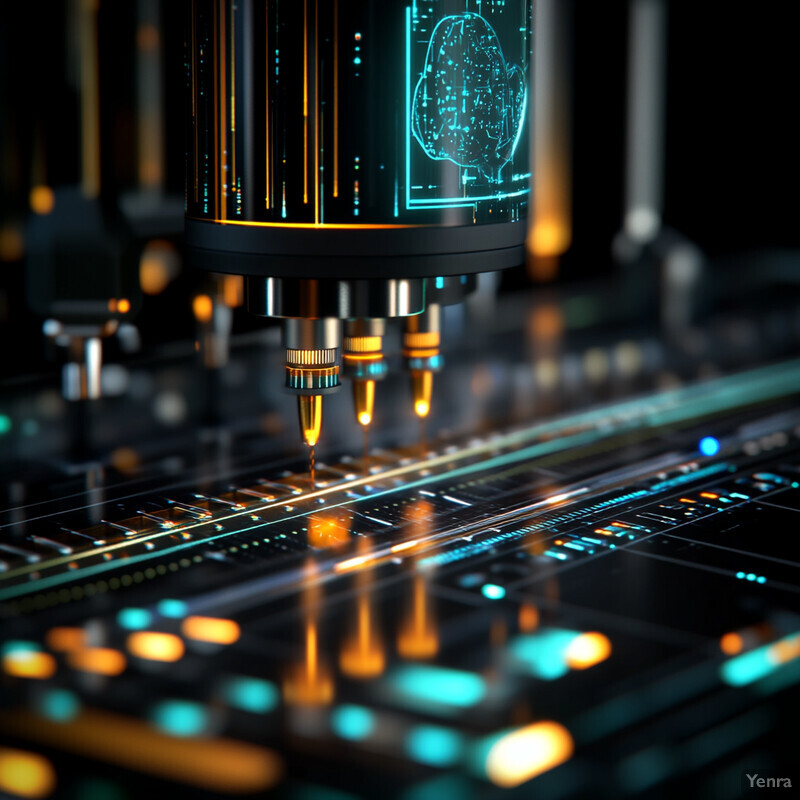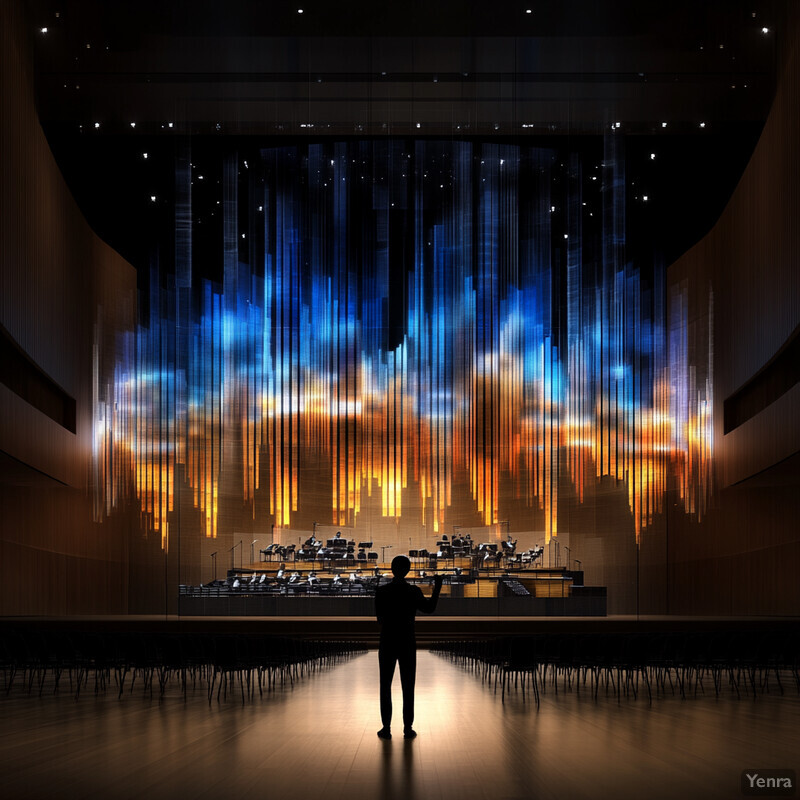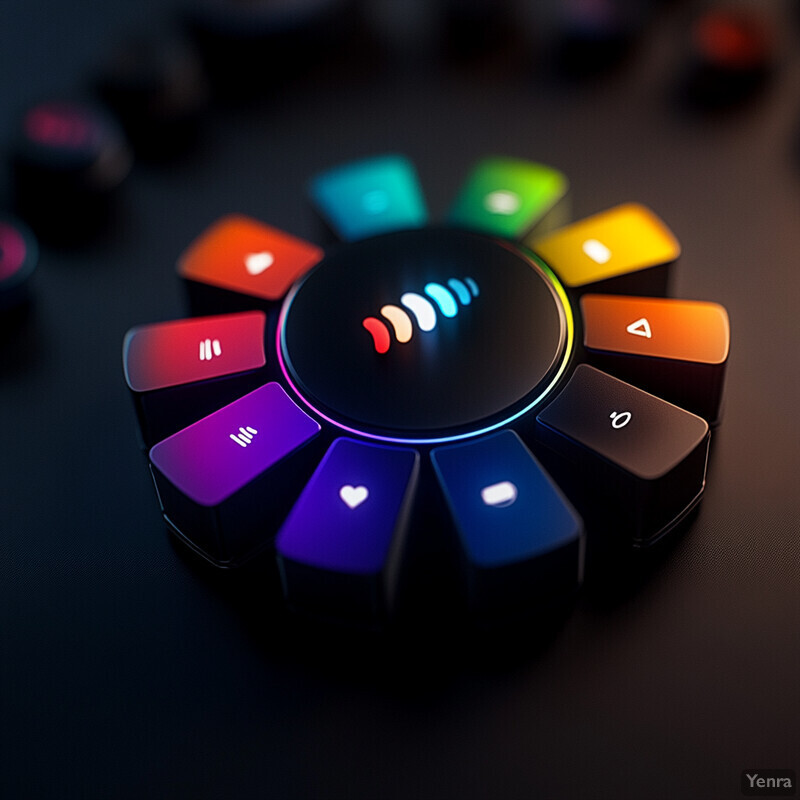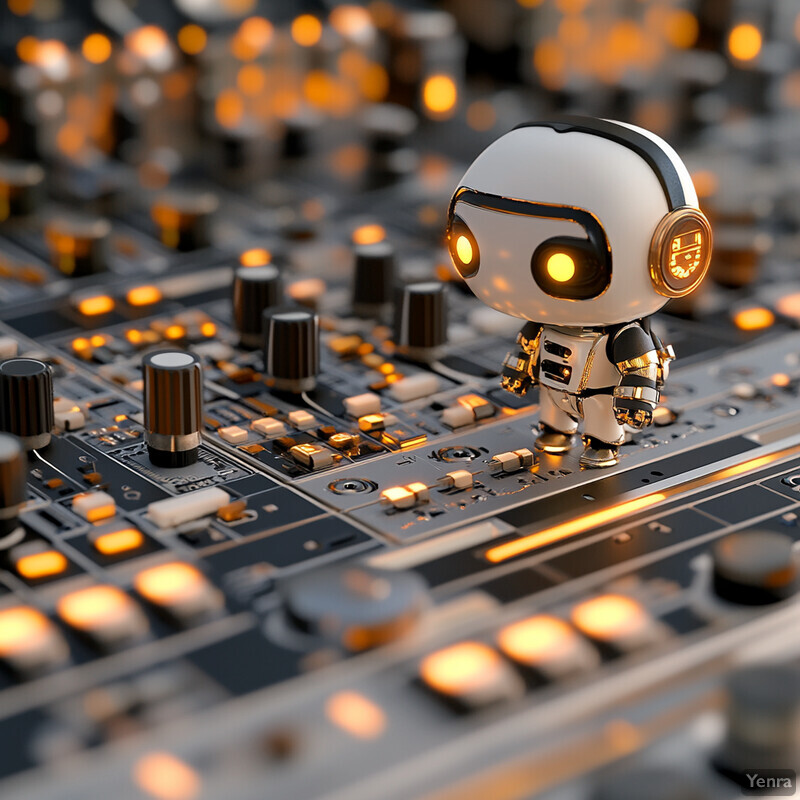1. Automatic Noise Reduction
Artificial intelligence has revolutionized noise reduction by learning to identify and remove unwanted sounds (like hiss, hum, and crackle) while preserving the music. Machine learning models are trained on vast datasets of noisy and clean audio, enabling them to distinguish noise from the intended signal with high precision. Unlike traditional fixed noise filters or gates, AI-based noise reduction adapts dynamically to different noise profiles and levels, cleaning audio without muffling the desired content. This leads to noticeably cleaner, more professional-sounding masters, especially for restoring old or poor-quality recordings that suffer from tape hiss or background hum. By targeting noise components selectively, AI can improve the signal-to-noise ratio and clarity of a track far beyond what manual techniques typically achieve.

AI-powered noise removal is now common in both music production and other audio applications. For example, Adobe’s “Enhance Speech” tool uses an AI model to “magically remove background noise and improve the quality of poorly recorded dialogue” with just a few clicks. Research confirms that deep learning methods outperform classic noise reduction filters in adapting to varied noise types: one 2024 study noted that traditional techniques often struggle with diverse noise profiles, whereas convolutional neural networks offer a data-driven approach yielding consistently better results. This ability of AI to learn the characteristics of noise means it can reduce unwanted sounds more aggressively without harming the music, achieving cleaner audio than was previously possible.
2. Smart EQ and Dynamic Processing
AI-driven equalization and compression tools automatically shape a track’s tone and dynamics by “listening” to the audio and making intelligent choices. Instead of relying on static presets, these smart processors analyze the frequency spectrum and dynamic range, identifying issues like masked frequencies or uneven levels. The AI then applies tailored EQ adjustments (boosting or cutting specific bands) and dynamic processing (compression or expansion) to enhance clarity and balance. Importantly, the changes are context-aware: the system preserves the mix’s character while fixing muddy or harsh elements. This smart EQ/dynamics approach can significantly speed up the mastering process, giving engineers a solid starting point that often requires only minor tweaks, rather than hours of manual trial-and-error.

Emerging AI mixing/mastering assistants exemplify these capabilities. For instance, iZotope’s Neutron and Ozone systems use machine learning to suggest EQ and compression settings optimized for the input audio. A user can let the AI “listen” to a mix; the software then provides a custom preset tailored to that track’s needs (such as cleaning up a muddy vocal or taming piercing highs). Independent research and user reports confirm that these tools help achieve professional-sounding results more efficiently. In interviews, intermediate-level music producers have noted that AI-assisted mixing/mastering enables “high-quality sounding songs and albums quickly without the need to…learn mixing and mastering or hire a professional,” leveling the playing field for those with less experience. In short, AI-based EQ and dynamics processors can automatically make many of the subtle adjustments a skilled engineer would, saving time while improving tonal balance and loudness consistency.
3. AI-Driven Source Separation
Advanced AI models can “unmix” audio, separating a full song into its individual stems (vocals, drums, guitar, bass, etc.). This capability allows mastering engineers to address issues in a specific instrument or vocal track even when the original multitrack sessions are unavailable. By isolating elements, an AI-driven separator makes it possible to, say, lower a too-loud vocal or EQ the bass independently before remastering the combined track. This granular control, enabled by neural networks trained on vast amounts of music, marks a huge leap over traditional tools. It means older stereo masters can be remastered in ways previously impossible – adjusting the mix balance or effects of single instruments – thereby greatly enhancing the precision and creative possibilities in remastering projects.

Research in 2023–2024 demonstrates significant improvements in music source separation performance due to AI. One example is a lightweight deep learning model called DTTNet (Dual-Path U-Net), which achieved a 10.12 dB improvement in signal-to-distortion ratio for separated vocals – slightly better than a prior state-of-the-art model’s 10.01 dB, while using 86% fewer parameters. In practical terms, this means AI separation is becoming both more accurate and more efficient. These advances have real-world impact: engineers can use AI separaters to extract individual instruments from legacy recordings and then remaster each component. AI-based tools (like Audionamix or open-source Demucs) are already being used to separate vocals from old mono recordings or split live concert tapes into stems for modern remixing. The fidelity of these separations continues to improve, indicating that AI is increasingly capable of producing high-quality isolated tracks that enable deeper remastering interventions than ever before.
4. Adaptive Room Emulation
AI systems can intelligently apply reverb and room ambience to a track by determining which acoustic environment best complements the music. Traditionally, choosing a reverb (such as a small club vs. a large hall) involves experimentation and subjective judgment. An adaptive AI approach can analyze the audio’s style, tempo, and instrument distribution, then suggest or apply an ideal reverb setting automatically. For example, an AI might decide a jazz ballad needs the intimacy of a studio room, whereas a symphonic piece benefits from a concert hall’s grandeur. The AI tweaks parameters like reverb time and early reflections to suit the track’s characteristics. The result is an enhanced sense of space and depth that fits the music’s mood – achieved with far less trial-and-error. This technology ensures that the added reverberation enhances the track’s atmosphere without overwhelming it, all while saving time in the mastering stage.

Early implementations of this concept are appearing in production tools. In 2024, Antares (makers of Auto-Tune) released an AI-assisted Vocal Reverb plugin designed to craft ambiences ideally suited to vocals. It combines a classic algorithmic reverb engine with “clever AI features… all designed to craft ambiences ideally suited to vocal production.”. In practice, the plugin’s AI can “learn” from the vocal track and help set reverb parameters (Plate, Room, Hall, etc.) that flatter that specific performance. It even offers an Assist mode that guides the user through optimal reverb settings based on the content. This kind of AI-driven room emulation ensures that each track gets a custom-tailored spatial effect – for instance, making a dry recording of a singer sound like it was recorded in a lush hall – with minimal user input. Such tools demonstrate how AI can automate the usually subjective process of matching a mix to the perfect acoustic environment.
5. Harmonic Enhancement
AI-based harmonic enhancers analyze the musical overtones in a track and can subtly add or amplify harmonics to improve warmth and clarity. Harmonics are the multiples of fundamental frequencies that give instruments their richness. Over time (or in low-quality recordings), some of these overtones may be weak or missing, resulting in a thin or dull sound. An AI harmonic enhancement tool will detect the harmonic structure of the audio and identify where overtones are lacking. It can then generate those frequencies – much like an exciter or analog tape saturation would – in a very precise way. The outcome is a fuller, more “musical” sound: bass feels richer with its upper harmonics restored, and vocals or guitars gain sheen and presence. Because the AI “understands” the musical context, it injects harmonics in a tasteful, unobtrusive manner, avoiding the artificial sound that naive harmonic generators might produce.

A cutting-edge example of this is in audio super-resolution, where AI models literally create high-frequency content that wasn’t present in the original low-fidelity audio. In 2023, researchers introduced AudioSR, a diffusion-based AI that can upsample audio from, say, a 8 kHz bandwidth up to 24 kHz, effectively restoring lost harmonics and high-end detail. Objective tests showed strong results, and subjective listening confirmed that AI-generated overtones can significantly enhance the brightness and clarity of music. In practice, similar technology is emerging in plugins that add “air” or “analog warmth” to recordings. These AI algorithms learn from examples of high-quality audio and can synthesize missing treble or enrich the harmonic spectrum. Consequently, a dull recording can be transformed: cymbals get their shimmer back and vocals regain a breathy brilliance, all through AI that continuously adjusts the harmonic content in musically appropriate ways.
6. Intelligent Loudness Control
Modern music is consumed on streaming platforms and radio with strict loudness standards, and AI can automatically optimize a track’s overall loudness to meet these targets. Instead of manually tweaking limiters and compression to hit, for example, -14 LUFS (Spotify’s norm), an intelligent system analyzes the track’s dynamics and adjusts the gain and compression transparently. Crucially, the AI does this without ruining the music’s dynamic range – it finds the sweet spot where the track is loud enough to be competitive but not over-compressed. By accounting for the specific requirements of each platform (like Spotify, Apple Music, YouTube, etc.), the AI ensures consistent playback volume. This prevents scenarios where one song is much quieter or louder than the next in a playlist. Intelligent loudness control essentially automates the final “volume check” mastering engineers do, reducing the risk of both overly quiet releases and the dreaded over-limited, distorted sound.

Loudness normalization is a real concern: a 2024 analysis of 200,000 songs by an AI mastering service found that 80% of DIY-mastered tracks exceeded Spotify’s recommended loudness level, and 57% of those tracks had audible clipping distortion. These figures highlight how common over-compression and loudness issues are in self-mastered music. AI tools directly address this problem. For example, some AI mastering platforms measure a track’s LUFS and true peak, then automatically apply just enough compression or limiting to hit the platform target (preventing the kind of clipping found in over half the analyzed tracks). The benefit is twofold: it spares artists from navigating the loudness wars on their own, and it ensures compliance with streaming standards. In practice, using AI loudness normalization yields tracks that hold their own in loudness next to commercial releases, without the pumping or distortion that often comes from less sophisticated volume-maximizing methods.
7. Spectral Shaping and Restoration
AI spectral shaping tools operate with surgical precision on the frequency spectrum of audio, fixing issues that human engineers might struggle to even detect. These tools create a visual map of the audio’s frequencies (a spectrogram) and use machine learning to find anomalies: for instance, a piercing resonance at 2.5 kHz, phase cancellations causing a hollow sound, or digital clipping artifacts. Once identified, the AI can attenuate or remove these unwanted spectral features – smoothing out harsh peaks, correcting phase misalignment, and even “reconstructing” clipped waveforms. The result is a cleaner, more tonally balanced master. Because the AI works in the frequency domain, it can differentiate, say, a guitar’s harmonic ringing (which should remain) from a spurious resonance (which can be toned down). This level of restoration was traditionally possible only with painstaking manual EQ notching or spectrographic editing, but AI can perform it automatically, improving fidelity and transparency in a fraction of the time.

A clear demonstration of AI’s power in this area comes from recent research on declipping severely distorted audio. In 2024, engineers introduced a neural declipper called DDD (Demucs-Discriminator-Declipper) that uses a deep network to repair clipped speech signals. In blind listening tests on harshly clipped audio, DDD “outperforms the baselines by a wide margin in terms of speech quality.” It also runs in real-time with sub-0.1 second latency, making it 6× faster than prior deep-learning declipping methods. This is a dramatic improvement—earlier tools often left distortion or required heavy offline processing, whereas the AI approach both sounds better and works instantly. In music mastering, similar AI-driven spectral tools (like those in iZotope RX and others) can detect problems like intermodulation distortion or spectral holes and fix them. They essentially “heal” the audio spectrum by comparing it to learned models of clean audio. The end result is a smoother, more pristine master track, achieved by literally rewriting problematic portions of the frequency spectrum based on learned knowledge of how good audio should look and sound.
8. Style Transfer from Reference Masters
In this application, AI learns the “sound signature” of a reference master recording and applies that style to another track automatically. Mastering engineers often use reference tracks (well-mastered songs in a similar genre) to guide their decisions. AI style transfer takes this a step further by quantitatively analyzing the reference’s EQ curve, compression behavior, stereo width, and overall tonal balance. It then adjusts the new track’s mastering settings to mimic those characteristics. For example, if the reference master is very warm with boosted low-mid frequencies and a gentle high-end roll-off, the AI will shape the target track in a similar way. This results in a cohesive sound match – the new track can have the polish and tonal vibe of the reference song, achieved in moments. This technique is invaluable for maintaining consistency across an album or matching a label’s signature sound, all without manual dialing-in of countless parameters.

Researchers have actively explored mixing/mastering style transfer. In 2023, Koo et al. demonstrated an AI system that “converts the mixing style of an input multitrack to that of a reference song.” Using contrastive learning, their model disentangled audio effects and successfully applied the reference’s EQ, dynamics, and spatial profile to target audio. Objective and subjective evaluations showed the AI’s masters sounded notably close to the reference’s style. This science mirrors real-world tools: platforms like LANDR now allow users to upload a reference track when mastering – the AI then uses that reference to guide its processing. According to an industry report, LANDR’s engine lets users “add reference tracks and choose between different styles and loudness levels” to automatically match a desired mastering style. In practice, this means an indie artist can tell the AI, “make my song sound like [famous track],” and the system will adjust tonal balances and loudness to emulate that reference’s sonic character. It’s style matching on demand, powered by AI’s ability to learn audio “textures.”
9. Batch Processing and Uniformity
AI can master large batches of tracks in one go, ensuring a consistent sound across all of them, which is particularly useful for albums, playlists, or entire music catalogs. In a manual scenario, an engineer has to replicate settings or carefully match tonal balances from track to track – a tedious process. An AI batch mastering system, however, analyzes each track’s audio profile (frequency content, loudness, dynamic range) and then applies a uniform mastering approach to all. This doesn’t mean every song gets an identical treatment; rather, the AI makes sure they all fall within the same sonic “family.” For instance, if you provide 10 songs, the AI will prevent one from ending up bass-heavy or significantly louder than the others. The result is improved cohesion: when these tracks are played sequentially, nothing jarring stands out. Batch processing through AI dramatically speeds up workflows for labels or services dealing with thousands of tracks, all while upholding a reliable quality standard for each mastered file.

One of AI’s touted benefits in mixing/mastering is exactly this consistency and speed. Industry reviews in 2023 noted that “AI mixing and mastering can help you ensure consistency across multiple tracks, making them sound like they belong together.” This is “particularly useful for musicians working on albums or EPs, where all the tracks need to have a consistent sound to create a cohesive listening experience.”. In practice, online AI mastering services leverage this capability: they can process dozens of songs in minutes, whereas a human might take days. The AI analyzes each song and applies a matching tonal balance and loudness. This batch efficiency is also highlighted by providers like LALAL.AI, which emphasize that AI mastering saves time by automating the mastering of multiple tracks “in a matter of minutes”. Additionally, companies report that AI-driven batch mastering drastically reduces repetitive tasks – the system doesn’t get ear fatigue or lose focus, so the 100th track in a batch gets the same attentive treatment as the first. The uniformity achieved means listeners can shuffle an album or playlist and experience smooth, professional sound throughout.
10. Adaptive Limiting and Clipping Control
Limiting is the final step that controls a track’s peak levels, and AI makes it adaptive by smartly distinguishing between transient peaks and sustained loud sections. A traditional limiter might clamp down uniformly once a threshold is passed, but an AI-driven limiter “understands” the musical content. It can apply stronger limiting to brief, spiky transients (to prevent clipping) while being gentler on sections that need to remain punchy. For example, a sharp snare hit might be limited more than a vocal sustaining a note, preserving the vocal’s natural dynamics. The AI essentially rides the line between loudness and distortion: it watches for potential clipping in real time and adjusts the gain reduction optimally. This results in masters that achieve competitive loudness without the ugly side-effects of over-limiting (such as audible distortion, pumping, or loss of impact). In effect, the limiter becomes “intelligent,” intervening only as much as needed for each moment in the track.

The integration of AI into limiters is exemplified by tools like Sonible smart:limit. Smart:limit uses an AI assistant to help users hit streaming loudness targets without unwanted artifacts. As an expert review describes, different streaming platforms have different loudness norms, and “software engineers have helpfully been introducing AI into the equation… [smart:limit] is a mastering-focused true peak limiter that includes the company’s AI assistant”. In use, smart:limit analyzes the track and can automatically set the limiting threshold for, say, Spotify’s target, while a built-in “Quality Check” indicates if more dynamics can be safely squeezed or if distortion is imminent. Tests on a house music track showed the AI limiter easily bringing the mix up to Spotify’s loudness spec without overshooting or audible degradation. This confirms that AI can handle the delicate balance of loudness vs. clarity: it prevented unwanted distortion by recognizing the difference between necessary limiting and over-limiting. By dynamically adapting to the content, AI limiters ensure each hit remains punchy and the overall track stays clean and loud.
11. Cross-Platform Mastering Presets
AI can automatically create different masters of the same song optimized for various release formats – for example, a master for Spotify streaming, another for vinyl pressing, and another for FM radio. Each medium has unique technical requirements: streaming services have loudness normalization and codec considerations, vinyl cutting engineers prefer certain dynamic ranges and no excessive stereo bass, radio has broadcast limiters, etc. With AI, a mastering engine can generate these presets in minutes. It does so by applying the appropriate target settings for each format (such as adjusting loudness to -14 LUFS for streaming, ensuring no extreme stereo low-end for vinyl, or adding a bit of extra compression for a radio-friendly master). This automation saves the mastering engineer from manually tweaking and re-exporting multiple versions. More importantly, it guarantees that each version is correctly optimized – the streaming master won’t trigger the platform’s volume reduction too much, and the vinyl master will be cut-friendly. AI essentially serves as an expert on each medium’s best practices and handles the fine adjustments needed for each one.

The benefit of tailoring masters to different platforms is well recognized. Each major service has its own standards, and going over or under can have consequences (e.g., Spotify turning down a loud track, or a quiet track being subject to aggressive normalization). An AI tool like Sonible’s smart:limit explicitly includes “publishing target” profiles for services like Spotify, YouTube, Apple Music, etc., and will show the user if the track meets that target. In a real-world mastering session, this means the AI can alert you that your mix is, say, 4 dB louder than Apple Music’s preferred level and suggest dialing it back. Audio industry tutorials note that “as of now, there’s no cross-platform standard – Spotify, Apple Music, YouTube – they’re all different. So how do you know how loud to make it?… [AI] software engineers have introduced AI into the equation” to simplify this problem. Services like Waves Online Mastering (launched in 2023) also emphasize that their AI will ensure a master “translates” well to all modern formats. In short, AI can encode expert knowledge of each playback medium’s requirements and apply it automatically, yielding multiple format-specific masters that each sound as good as possible in their intended environment.
12. Predictive Correction Suggestions
Some AI mastering systems don’t just process audio – they actively suggest improvements to the mix before mastering is applied. This might include warnings or tips like “the bass is very boomy around 120 Hz” or “consider de-essing the vocals to reduce sibilance.” By analyzing the pre-master mix, the AI can predict issues that would hinder a great master and prompt the user to fix them early. This streamlines the workflow: instead of discovering a problem after mastering (and then having to go back to the mix stage), the engineer can address it upfront. For less experienced users, these AI suggestions are also educational, effectively guiding them toward better mix practices. Examples of such suggestions could be recommending a slight EQ cut on a muddy instrument, or indicating that the dynamic range is too wide/narrow for optimal mastering. Ultimately, predictive suggestions help ensure the audio fed into the mastering stage is as good as it can be, making the final mastered result better.

iZotope’s software suite offers a real example of this functionality. Repair Assistant in iZotope RX uses AI to automatically analyze a mix and then “offers options for you to consider” in fixing any problems it finds. In practice, when you run Repair Assistant on a track, it might detect clipping, clicks, hum, or other issues and then suggest a chain of processors to repair those (with the user confirming or tweaking the suggestions). Likewise, iZotope Ozone’s Mastering Assistant will listen to a mix and recommend mastering moves – for instance, it might highlight excessive sub-bass or hint that the mix could benefit from stereo widening, giving the user a chance to adjust the mix or approve the AI’s settings. A 2023 user study indicated that such AI-driven feedback is especially helpful for musicians working without an audio engineer: the AI can identify trouble spots like “excessive sibilance” or a need for a bass roll-off and guide users to make those adjustments, thereby improving the final outcome. This proactive approach reduces the back-and-forth between mixing and mastering, and even seasoned engineers appreciate the “second set of ears” the AI provides to catch issues they might miss after long mix sessions.
13. Metadata Analysis and Integration
Beyond the raw audio signal, AI mastering tools can ingest metadata about a track – such as the song’s genre, tempo (BPM), key, or even the instrumentation – and use it to inform mastering decisions. This extra context helps the AI tailor its processing more appropriately. For example, knowing the genre can set different EQ targets (a hip-hop track might warrant heavier bass and crisp highs, whereas a classical piece needs a flatter, more natural response). Tempo and rhythmic metadata can influence compression settings (fast EDM might handle stronger compression than a slow ballad). Key signature might even guide an AI to be careful around certain frequency ranges critical to the melody. By integrating metadata, the AI moves away from a one-size-fits-all approach and towards a context-aware approach, mastering a track in line with its musical identity. This leads to results that sound genre-appropriate and musically coherent, with the AI effectively applying “mastering by genre/style” rules that human engineers use, but in an automated way.

Practical implementations are emerging. LANDR’s new AI mastering plugin, for instance, will “detect the genre and create a custom mastering chain to suit” the track. In a use-case, if you drop in an uptempo electronic dance track, LANDR’s AI might automatically recognize it as EDM and adjust its chain – perhaps adding a tighter low-end compression and a bit of high-end excitement – differently than it would for, say, an acoustic folk song. This genre-detection feature is essentially reading metadata (or using audio analysis to infer metadata) and then altering the mastering accordingly. Another example is Sony’s research: an AI system by Sony was shown to encode “audio effects related information from a reference music recording” (i.e., metadata about the production style) and use that to drive a mixing style transfer. On the consumer side, even simpler uses exist – some AI mastering services ask the user to specify the genre or “vibe” of the track before processing, which is a manual input of metadata that the AI uses to tweak its output. All these cases show that feeding contextual info (genre, key, etc.) into AI yields more relevant and satisfying masters, as the AI can make decisions aligned with the track’s intended style.
14. Real-Time Mastering Feedback
Traditionally, mastering has been somewhat iterative – you make adjustments, export or preview the track, listen, then adjust again. AI is changing this by providing instant feedback during the mastering process. Modern AI-assisted mastering tools can display visual indicators (and even audio previews) of how changes will affect the master in real time. For instance, as an engineer tweaks an EQ band, an AI system might show how the overall loudness or spectral balance is impacted immediately, or even flash a warning if too much adjustment could cause distortion. Some systems can predict the outcome of a change before you fully apply it, saving time and preventing mistakes. This interactive loop makes mastering more intuitive, especially for those less experienced – it’s almost like having a virtual mastering coach nodding or shaking its head at your decisions. Real-time feedback fosters a faster workflow (no need for repeated exports to hear changes) and can lead to a more polished final product, since issues are caught and addressed on the fly.

A good illustration is the “Quality Check” feature in Sonible’s smart:limit, which provides real-time guidance. As a user is mastering a track, the plugin might indicate, for example, that the track’s dynamics are outside the ideal range for the chosen genre and recommend increasing the input gain. When the user adjusts the gain slider, they can see instant changes in the loudness/dynamics graph and the AI immediately re-evaluates the signal. This means the tool is actively coaching the user toward an optimal master in real time. Another example comes from an Ars Technica report: “AI-powered mastering systems allow endless tweaking… [and] return results within a minute”, whereas human mastering engineers might require multiple revision cycles. In fact, Apple’s Logic Pro now has a “mastering assistant” that will analyze and adapt as you make adjustments, previewing how loudness normalization on streaming platforms will affect the track on the spot. All these developments point to a trend: AI is enabling a master-as-you-go approach. Instead of waiting to hear the consequences of a tweak, the AI and user are in continuous dialogue during the session, leading to faster and better-informed mastering decisions.
15. Adaptive Stereo Imaging
AI can automatically adjust the stereo field of a track, deciding which elements to spread out wide and which to keep center-focused, in order to enhance the overall spatial impression. In mastering, maintaining mono compatibility (the mix still sounds good if summed to mono) is important, so engineers must be cautious with stereo widening. An adaptive AI-driven imager evaluates the phase and stereo information in the mix and then makes subtle enhancements. For example, it might widen the backing vocals and synth pads a bit for a lusher feel, but keep the kick drum and bass centered to retain power and mono compatibility. If something is too wide (causing a hollow sound in mono), the AI can actually narrow it. Conversely, if the mix sounds too narrow or clustered in the center, the AI can introduce gentle stereo expansion to appropriate frequencies. The end result is a master that sounds immersive on stereo speakers or headphones, yet still punchy and clear on mono devices. The AI essentially takes on the task of balancing stereo excitement with technical reliability.

AI mastering engines explicitly include stereo imaging as a parameter they optimize. For instance, the RoEx audio platform describes its AI mastering engine as ensuring “release-ready audio by optimising loudness, tone, and stereo width”, giving every track a consistent polish. In practice, this means the AI examines a track’s stereo content and makes any needed adjustments. If a user uploads a song where, say, the hi-hats are almost inaudible in one channel, the AI might detect this imbalance and widen the overall image to compensate. Or, if a mix has phase issues from an overly wide synth, the AI could subtly reduce the width in that problematic range to avoid phase cancellation. We’ve also seen AI suggestions in action: users of iZotope Ozone’s Master Assistant reported that the AI often suggested reducing stereo width in certain frequency bands when their mix was “too wide,” aligning it more with typical commercial mixes. This shows the AI isn’t just blindly widening everything – it’s intelligently judging where and how to adjust stereo imaging. Through these nuanced tweaks, an AI-managed stereo field can achieve the ideal balance where a track feels wide and enveloping but retains focus and solidity where needed.
16. Customizable Personal Taste Profiles
AI mastering can be personalized by learning an individual user’s sonic preferences over time. Professional mastering engineers often develop a signature style; similarly, a user can “train” an AI on examples of their favorite sound. This might involve feeding the AI with a set of tracks that exemplify the desired aesthetic or allowing it to analyze past mastering decisions the user made. The AI then creates a profile – essentially a custom preset – that reflects those tastes (e.g., maybe the user likes solid, punchy low-end and smooth, rolled-off highs). Going forward, when the AI masters new tracks, it will apply that profile, yielding results aligned with the user’s preferences. Users can usually tweak these profiles, refining them as they go (like telling the AI “a bit more brightness” or “less bass” consistently). Over time, the AI becomes a personalized mastering assistant that doesn’t just aim for a generic “ideal” sound, but rather the sound you love. This drastically reduces the need for repetitive tweaks on each new project, since the AI already knows your style.

The concept of integrating user preferences into AI mastering is a natural evolution noted by researchers. A 2023 study on intelligent music production argued that “ideal intelligent music production systems should produce results reckoning the users’ preferences,” because producers often draw inspiration from reference music and have personal taste goals. In line with this, some commercial tools have introduced rudimentary preference learning. For example, LANDR’s platform allows users to choose between different mastering “styles” (e.g., Warm, Balanced, Open) and remembers their choices, effectively shaping a taste profile that the algorithm uses. Likewise, iZotope Ozone lets you input a reference track – which is a way of telling the AI your target sound – and you can consistently provide similar references to steer it. We’re also seeing user-trained AI in other audio domains; for instance, certain AI EQs learn from user adjustments to better predict what settings the user might want next time. All these developments echo the same idea: the more the AI is exposed to a specific user’s examples or corrections, the more it adapts. This leads to anecdotal reports of AI masters that “consistently deliver results aligned with [the user’s] stylistic vision” as the system refines its understanding of what you consider a good sound. It’s a burgeoning area, but one clearly aimed at making AI mastering feel less like an automated black box and more like an extension of the user’s own ears.
17. Automated Vintage Emulation
AI is enabling digital mastering to include the coveted coloration of vintage analog gear at the touch of a button. Classic hardware like tube equalizers, tape machines, and optical compressors impart distinct harmonic warmth, saturation, and compression characteristics that many producers love. AI models can be trained on the input-output behavior of such analog units – effectively “learning” how a 1970s tape machine would color the sound, for example – and then apply that behavior to any track on demand. This means an AI mastering chain can, say, emulate a famous SSL bus compressor gently gluing a mix, followed by a tape saturation that adds subtle distortion and fatness, without the user needing those physical units. Because it’s AI-driven, the emulation can dynamically adjust to the music, potentially even more fluidly than static plugin emulations. The end result is a modern master that nonetheless carries a nostalgic analog character (e.g., smoother highs, richer low-end, and pleasant saturation on transients) as if it were processed through vintage gear – all done automatically by the AI deciding where and how to apply these colorations.

Several plugins have emerged that use AI to model analog gear with impressive accuracy. One example is Baby Audio’s TAIP, a tape saturation plugin described as using “AI neural networks to mimic the characteristics of tape processing,” resulting in “an incredibly authentic” tape sound that adds warmth to tracks. Unlike traditional tape simulators that rely on static algorithms, TAIP’s neural network was trained to reproduce the nuanced nonlinearities of real tape machines, and producers find it effectively captures the analog vibe (like the slight compression and bass rounding of tape). Another case is the Fazertone Overdrive Essentials bundle, which provides “incredibly realistic AI-modeled emulations” of classic guitar overdrive pedals (Tube Screamer, RAT, etc.). In these, the AI learned the exact distortion profiles of vintage circuits and can recreate them digitally. In the mastering context, we now have AI-driven analog-style EQs and compressors as well. For instance, an AI model might emulate a Pultec tube EQ’s gentle boost character; applied to a whole mix, it imparts that beloved analog sheen. According to industry reports, the advantage of AI here is consistency and speed – the AI can apply vintage emulation consistently across an entire album, and switch between different vintage “flavors” in seconds. As a result, engineers can achieve a “timeless analog warmth” in their masters without investing in or physically operating old hardware, with the AI ensuring the effect is dialed in optimally.
18. Real-Time Cloud Collaboration
AI-driven mastering platforms based in the cloud allow multiple people (often the artist, producer, and mastering engineer, who might be in different cities) to collaborate and make decisions in real time. In a traditional scenario, an engineer would send a mastered track, the artist gives feedback, and revisions ensue – a back-and-forth that could take days. With cloud AI mastering, everyone can upload or stream the track to an online interface, apply different mastering settings nearly instantly via AI, and all parties can audition the results immediately from their own location. They can A/B compare different master versions on the fly. Because the AI renders changes so quickly (often in seconds or under a minute), it’s feasible to experiment collaboratively in real time (e.g., “Version A has more bass, Version B has more brightness – which do we prefer?”). This streamlines approval processes and ensures that the final master satisfies all stakeholders. Essentially, AI + cloud means mastering is no longer a slow, solitary final step, but can be an interactive, collaborative experience akin to a live studio session, just in a virtual space.

The capabilities of cloud-based AI mastering are evidenced by platforms like BandLab and others offering instant online mastering. BandLab advertises “Master as many tracks as you want. Fast. Up to 10× faster than the competition.” – meaning their cloud AI can generate masters in seconds for immediate feedback among collaborators. This speed enables a scenario where an artist in one location and a producer in another can both listen to a newly mastered track almost as soon as it’s uploaded, and if something’s off, adjustments can be made and heard right away. For higher-end use, Abbey Road Studios (London) uses a tool called Audiomovers that allows real-time, high-resolution audio streaming to multiple listeners. While Audiomovers is not itself an AI mastering processor, it pairs with AI mastering or digital audio workstations to let geographically dispersed team members simultaneously hear mastering tweaks as they’re applied. The result is a significantly accelerated revision loop: a process that might have taken a week of sending files and emails can happen in an afternoon via shared cloud sessions. According to industry anecdotes, this has been especially useful in the pandemic/post-pandemic era – albums have been mastered with artists and A&R reps listening in from home, thanks to AI’s quick processing and cloud collaboration tools making it all seamless. The final approval, which used to be a bottleneck, is now often just a live chat away.
19. Contextual Loudness Matching
AI can ensure that when multiple tracks are played in sequence (like on an album or playlist), their loudness and tonal balance feel consistent to the listener. Traditionally, mastering engineers perform “album mastering” where they adjust each song in context so that none sticks out as too loud, too soft, too bright, or too dull compared to the others. An AI can automate this process by analyzing the whole set of tracks together. It will adjust the gain of each track to match a target loudness and make subtle EQ tweaks if one track’s tone is mismatched (for example, a song recorded at a different time that sounds noticeably darker can be gently brightened to fit with the rest). This contextual approach means the listener won’t need to adjust volume between songs, and the collection of tracks will flow naturally. It greatly enhances the listening experience for albums and playlists, making them sound like a coherent body of work rather than just a collection of disparate songs.

The need for contextual matching is well documented. As one audio blog noted, “consistency across multiple tracks [is] particularly useful for albums or EPs… to create a cohesive listening experience.”. AI mastering services explicitly aim for this: they often normalize the loudness across all songs to the same level and use reference-based processing to unify tone. Spotify and other streaming platforms already perform loudness normalization on playback (targeting about -14 LUFS per track), but AI mastering can do a more nuanced job beforehand. For instance, if Track 5 on an album is a solo piano piece that’s inherently quieter, an AI might decide to master it a bit louder than it would in isolation, so it doesn’t drop too far below the loudness of a big pop song before it. Or it might recognize that two songs in a playlist share a similar vibe and ensure their bass and treble levels align nicely. In practical testing, when an AI mastering platform processes an entire album, users often report that the songs gel better. One user from a 2024 academic project mentioned past projects “always suffered from very jarring shifts between songs” but found that through proper mastering (as can be done by AI), they could mitigate those differences and achieve smooth transitions. This underscores that contextual loudness and tone matching – once the domain of skilled human ears – can now be reliably handled by AI algorithms, resulting in a uniformly polished collection of tracks.
20. Continual Self-Improvement
AI mastering systems actually get better over time. Unlike a static piece of hardware, an AI model can be updated with new training data and learn from more examples, including feedback from users. This means the more music the AI masters, the more it refines its decisions. Early on, an AI might struggle with a particular genre or rare audio issue, but after being exposed to more cases (and possibly being corrected either by human engineers or automated evaluation), it will adapt and improve. This continual learning can happen through formal retraining (for instance, developers feed the AI thousands of new tracks and their desired masters) or through on-the-fly adjustments. Consequently, today’s AI mastering is noticeably better than a few years ago, and it’s plausible that next year’s will be better still. Over time, the AI may also expand its “knowledge” – learning new styles as they emerge, or new reference standards – ensuring it stays up-to-date with contemporary music and technical requirements. This self-improving nature means that investing in an AI mastering platform is not static; the tool evolves and often yields progressively more polished results as it gains experience.

Real-world evidence of this continuous improvement is provided by long-running AI services like LANDR. Since launching in 2014, LANDR’s mastering AI has processed a huge volume of music and has been iteratively enhanced. By 2023, LANDR reported that its algorithms had “spent the last decade mastering more than 25 million tracks,” learning from each, and that “Grammy Award-winning audio engineers have spent thousands of hours personally training [the] AI mastering engine.”. The direct result of this continuous training is an AI that makes more refined choices – for example, early versions of LANDR might have been criticized for over-compression, but newer versions are widely regarded as more subtle and musical, having absorbed the mastering techniques imparted by experts. Another data point: OpenAI’s research in related audio AI fields shows that models improve by absorbing diverse data – an AI that’s exposed to more genres (rock, electronic, orchestral, etc.) becomes capable of handling each style more adeptly, whereas a less-exposed model might have had a bias or weakness. The LANDR team even launched an upgraded engine (in 2023) called Synapse, explicitly citing that it incorporated nearly a decade of user feedback and millions of mastered tracks to enhance the AI’s decision-making. In summary, the longer an AI mastering system operates and learns, the more its “ear” approaches that of seasoned mastering engineers. It continuously fine-tunes its processing rules to adapt to new trends and rectify past shortcomings, truly living up to the promise of an ever-improving automated mastering assistant.